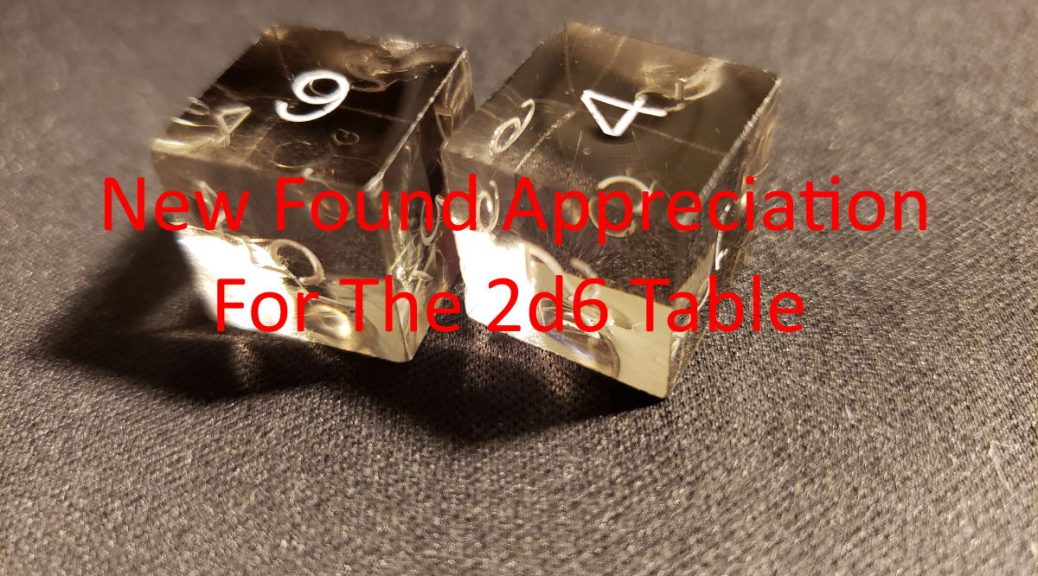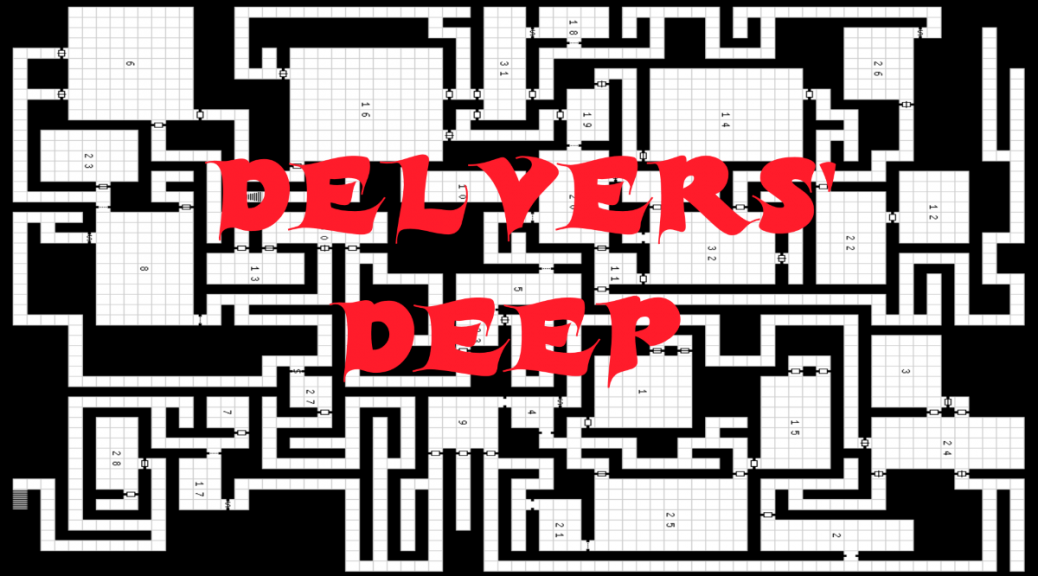On September 12, 2019, I started a new Thursday night Roll20 campaign using Delving Deeper, called Delver’s Deep. Delving Deeper is a re-organization of OD&D(Original Dungeons & Dragons), AKA the 3 LBBs (Little Brown Books) in the first box set. My last post talked about campaign prep and linked to my podcast where I discussed it. [UPDATE: Here’s the companion podcast.]
I reviewed OD&D [Affiliate Link] , Holmes Blue Box Basic, Moldvay [Affiliate Link] , and Cook [Affiliate Link] . and Rules Cyclopedia [Affiliate Link] looking for the classic 2d6 morale and reaction tables. First, I was surprised to see that OD&D Book I, Men & Magic [Affiliate Link] only has the 3d6 loyalty table on page 13. It mentions checking morale, but I didn’t find an explanation of that mechanic via a PDF search.
[UPDATE: A comment posted that the reaction table is on page 12 of book 3, but it is labelled: Random Actions by Monsters. It has three tiers with instructions to modify based on various factors.]
The classic 2d6 table is in Holmes for the Hostile/Friendly Reaction Table. Since it didn’t use the normal language I had to flip though my book to find it. Moldvay has the 2d6 Retainer Reaction on page 21 and Cook has no table but uses text to describe the 2d6 Morale Check. Ouch, that’s hard to read at a glance. The Rules Cyclopedia [Affiliate Link] has the 2d6 table on page 93. I looked at Blueholme [Affiliate Link] and it has a 2d6 reactions table. all with the classic. five options tending towards neutral in the middle with degrees of positive or negative on the upper and lower end.
I had the realization the other day that a 2d6 additive table, where the results of 2d6 are added together has 11 possible options. 11 goes into 100 nine times with a remainder of 1. As I thought about 11 options and there being 9% if the table was evenly distributed, I recalled my EMT training and a past article on the Rule of Nines. This gives a 2d6 table a possibility of representing the chance of a hit being a particular location – at least by the number of available options. One slot for each arm, one for the head, two for each leg, and four slots for the torso.
I was driven by thoughts of a hit location table for a possible Western RPG. I keep going back and forth between doing my own Western RPG or a generic Western campaign building supplement. I looked to AnyDice to get the percentages in perspective, and was quickly reminded that two or more dice added together have a bias towards the middle. This article on AnyDice explains the details.
My hopes were slightly dashed for making a balanced table that gives a balanced chance to a certain area of the body. It is close enough, that it might be OK in practice. I’m no math guru. I know just enough about statistics to have a general feel for them, but the nuts and bolts of the analysis is beyond me.
Here are the mentioned tables for reference:

The 2d6 Reaction Table from Delving Deeper with the total of the chance of results based on the sum of the values from AnyDice.

I liked the number of options, five, on the 2d6 Reaction and Morale tables, so I used the same values to create a table for the god of luck in my new campaign. The name, Losefka, comes from the religion and deity generator tables from Table Fables II by Madeline Hale. I decided that if you were a devotee or cleric of the god of luck and fate, you would have a hold coin for binary decisions and roll the holy bones each morning to determine your luck or fate for the day in the following table, screenshot from my Roll20 macro.

So far, there is a cleric of Losefka who has used the above table each day. There is a potential bonus/penalty for persistence in checking each day or failing to do so.
2d6 Appreciation
I have a new appreciation for the simple 2d6 additive table. The most common number of options for 2d6 tables in Delving Deeper are five options on the Morale and Reaction Tables. Seven options on the Wilderness Weather Table. Eight options on the Random Dungeon Location Table used for dungeon creation/stocking. If you want a number of results with even distribution, it is easier to use a single die of the right size for single digits or even divisible by 2, 3, or 4.
I have read lots of articles about 2d6 tables with the classic five tiers as in the Reaction and Morale Tables. When I searched for the tables from my recollection, I realized I had conflated re-use of the reaction/morale table and dungeon restocking. Various blog posts about both below: (It’s easy for all the blog posts I’ve read over 11 or 12 years of following the OSR to blend together. Some of these I read when they were new, and some from 2017 and later are new to me.)
- Restocking The Dismal Depths
- Dungeon Restocking and Rival Adventuring Parties
- 2013-08-21 One Roll Dungeon Stocking
- Riffing on 2d6: Reaction Rolls
- One table to rule them all – using 2d6 [or 3d6] for everything in D&D (This is a good analysis along my line of thinking.)
- Monsters can be Friends, Too! Monster Reactions
- WHAT DO THE MONSTERS WANT?
- Remember the Reaction Roll
- Why B/X Is My Favorite #16
- Encounter Reaction/Morale Table
- 2d6 vs. 1d6
- A Different Type of “Skill Check”
In addition to the results one gets from adding 2d6 one can use 2d6 to generate simultaneous options for a single roll to get two independent d6 results, like for dungeon restocking. There are also d66 tables where one can get 36 different options using one die for the tens digit and the other for the ones digit. This is seen in Maze Rats [Affiliate Links] and Knave [Affiliate Links].
Conclusion
I don’t think I (and perhaps we) need to reinvent the wheel for tables. I am growing to like the simplicity of OD&D/Basic as expressed in Delving Deeper. Variations on existing tables can be used to get a good spread of options for all kinds of things from moral and reactions, to re-stocking, to wondering monsters, and checking one’s luck/fortune each day. While I think the d10/20 made a more balanced to hit chance for combat, we don’t necessarily need to use dice in all the Platonic solids.
I think it is more that we don’t need to invent tables and mechanics to allow us to use all the different die types. Some die types lend themselves to a more balanced approach. A prime example is the 2d6 hit location table that started this whole thing. There is a d12 with body parts on it that gives an even chance for any body part. The one I have is not balanced, so making a table and using a balanced die would give more far results.
If you need 2 results of equal probability just roll any die and go high/low. If you need 3 balanced results roll a d6 and divide by 2, etc. I think using the die type that best fits the spread of what you are seeking, whether a weighted value or equal odds for any result makes the most sense.
Don’t get me wrong, I love my dice, or magic math rocks, as some call them. I love the challenge of making a useful table for each die type. However, I have a growing love of simplicity and minimalism in prep and at the table.
For my Delver’s Deep campaign I am trying to use all the different resources I have besides Delving Deeper. AD&D [Affiliate Links] , Table Fables & Table Fables II [AMAZON Affiliate Link], d30 DM Companion [Affiliate Links] , d30 Sandbox Companion [Affiliate Links] , story cubes, various card decks, etc. I’m trying to avoid making everything too similar to everything others have done, and also creating more variety in the setting and dungeon so it has both unique and interesting results. Crafting a story to make it all fit together is half the fun!


